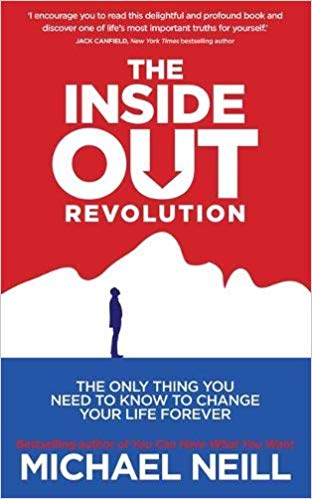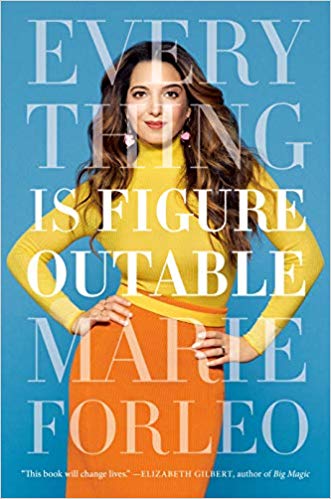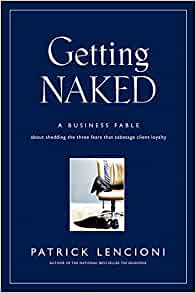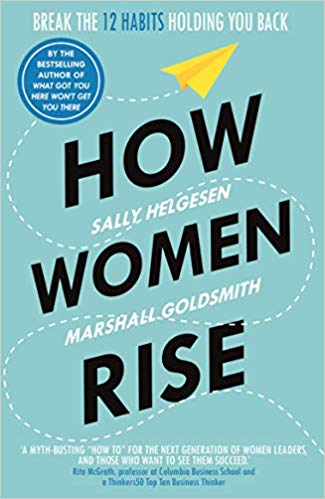Here are 5 books I recommend reading.
“The Inside Out Revolution” by Michael Neill
The idea is summed up well in the chapter called The Paradox of Results:
“when we take the pressure off ourselves to produce results at any cost, and instead rest in our innate well-being, enjoying our life, following our wisdom … things often seem to unfold more beautifully than we ever could have imagined. We start to notice all sorts of synchronicities and serendipities, and outcomes that may have eluded us for years begin to happen seemingly ‘all by themselves’”
Key quotes:
“Mind is the intelligence of all things; Consciousness makes you aware; and Thought is like the rudder of a ship”
“We’re only ever one new thought away from a completely different experience of being alive”
“Frustration isn’t feedback about quality of life, it’s feedback about the quality of our thinking”
“We don’t create abundance. Abundance is always present. We create limitations” (a quote from Arnold Patent from his book Money)
2. “The Untethered Soul” by Michael A. Singer
- Listen to your thoughts, but understand that they don’t define you.
- There’s a well of energy deep inside you. Don’t block it, but learn to let it flow.
- You can never live a fear-free life. The only way to transcend fear is to let it go.
- When you widen the focus of your consciousness, you transcend the confines of your personal self.
- The idea of death helps us look at our lives with a clearer lens, and prioritize what’s important.
- Finding the balance between extremes, or Tao, is an essential part of spiritual awakening.
3. “Everything Is Figureoutable” by Maria Forley
Key Lessons
Impossible Is Only What You Believe Is.
Just think of what Elon Musk : he’s building rockets that should take humanity to Mars in some not so distant future. Would he have even started doing that if he didn’t believe it was possible? Of course not.And this is where Forleo’s philosophy of life is rooted in. She firmly believes that your life will start getting better the very minute you stop believing that “achieving your dreams are impossible” and start using her mother’s mantra: “everything is figureoutable.”Your Road Map to Results
#1. Train your brain for growth
Instead of thinking things like “I know this already” or “This won’t work for me”– start constantly asking yourself questions such as “What can I learn from this?” and “How can this work for me?”
#2. Try it before you deny it
The everything-is-figureoutable philosophy of life is based on three rules of play:
- Rule 1. All problems (or dreams) are figureoutable.
- Rule 2. If a problem is not figureoutable, it’s not really a problem—it’s a fact of life or law of nature (e.g., death or gravity).
- Rule 3. You may not care enough to figure this problem out or achieve this particular dream. That’s okay. Find another problem or dream that ignites a blazing fire in your heart and go back to Rule 1.
#3. Eliminate excuses and do the work
#4. Fear is not your enemy
On the contrary, fear is your soul’s GPS. Reinterpret your fears and follow them: they’ll lead you in the right direction.
#5. Start before you’re ready and strive for progress, not perfection
The World Needs Your Special Gift
Finally, and most importantly, never forget that you are a unique human being with unique qualities and the capabilities to make unique contributions to this world.
“The world needs that special gift that only you have.”
4.“Getting Naked” Patrick Lencioni
This is a story about a management consulting firm, who tries to acquire a successful running boutique consulting firm.
The value
The model, called the naked service, is based on one thing i.e. Vulnerability. To be vulnerable means embracing humility, selflessness and transparency for the good for the client.
Three fears
There are three fears that prevent us from embracing vulnerability.
- Fear of losing the business
- Fear of being embarrassed
- Fear of feeling inferior
Shredding these fears
The model also talks about practices that one should use to shred these fears.
Shredding Fear of losing the business
- Always Consult instead of Sell — Naked consultants avoid, as much as possible, tell clients what they would do when hired, instead they start serving them as if they were hired already.
- Give away the business — develop long term relationship with the client, sometimes sacrificing the short term revenue.
- Tell the kind truth —Naked consultants will confront the client with a difficult message, the one the client might not like hearing, even at the cost of putting the relationship with the client at risk
- Enter the danger — Instead of avoiding “elephants in the room”,
Admit your limitations and weaknesses
No one is perfect and everyone has their weakness. By covering those, we are trying to be something we are not, which prevents us from doing our best in areas which we can thrive.
5. “How Women Rise—Break the 12 Habits Holding You Back from Your Next Raise, Promotion, Job” by Sally Helgesen and Marshall Goldsmith, Hachette
The authors demonstrate their awareness that women frequently define career success differently than men. Even so, many women still report feeling stuck. They may sense that (1) something is preventing them from moving forward or leading the life they are supposed to be living, or that (2) they are unable to break through circumstances that are conspiring to hold them down or (3) as if their contributions are not being fully recognized, appreciated, or rewarded, or that (4) people around them have no idea of what they are truly capable of achieving (pp.16-17).
Part 2—The Habits that Keep Women from Reaching Their Goals
The authors launch into this section by noting that this collection of self-sabotaging behaviors is not true of all women and is not true of women alone. Men may struggle with these same behaviors. some of these self-limiting habits are actually authentic, gender-specific strengths that are being overused. Strengths, overused, become constraints! The authors invite their female readers to pause, celebrate who they are, and decide not to be too hard on themselves—an exhortation woven throughout the book.
Part 3—Changing for the Better
The authors begin wrapping up with this: “It’s humbling to admit that what used to work for you has stopped working, and a little scary because familiar behaviours can feel like part of who you are. But it’s inspiring to consider how much you might benefit from letting them go” (p. 189). The 12 habits actually form clusters of related behaviours but, it’s vital to address these behaviors one at a time. First, state your purpose. Articulate “concisely and precisely what you hope to achieve, either in your present job or over the long term” (p.194). Tie your first steps and experiments to this clear purpose.
As you begin to challenge yourself to overcome one habit at a time, enlist help. Picking the right people is vital and, once you’ve done so, invite feedback and listen well. Engaging with a professional coach can accelerate your progress. Inviting a trusted co-worker into a “peer coaching” relationship may support your growth as well.
Finally, let go of the temptation to judge yourself. The authors suggest that women can be harder on themselves than men generally are. Eliminating habits is challenging work. Success takes time. Everyone’s journey includes trips and falls as well as moments of confusion and feeling lost. If you succumb to judging yourself for struggling or judging others for failing to support you as you would have hoped, your journey will be unnecessarily complicated and stressful.
“Successful women tend to be avid self-improvers” (p. 227). So the authors invest their last few pages in affirming women. Hard work and real strengths have gotten you this far. Don’t be too hard on yourself! Watch out for either-or thinking. “We believe that far more women could and should be in positions of power and influence. We hope that our ideas will ultimately help you rise in your chosen field or organization so you can make even more of a positive difference in the world” (p. 230).






